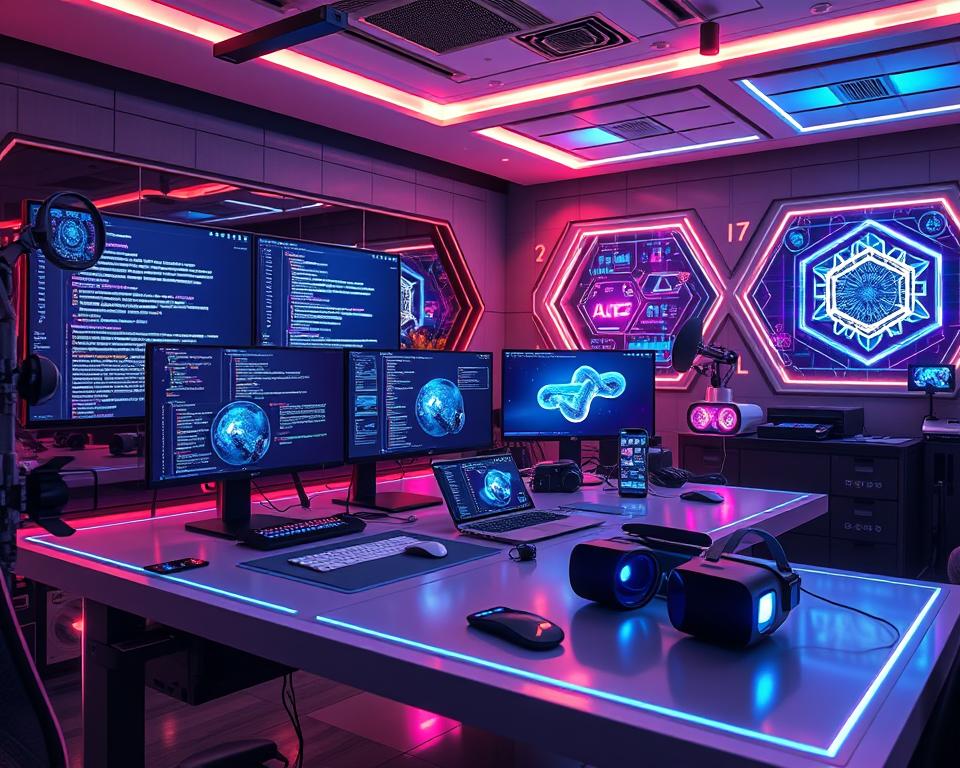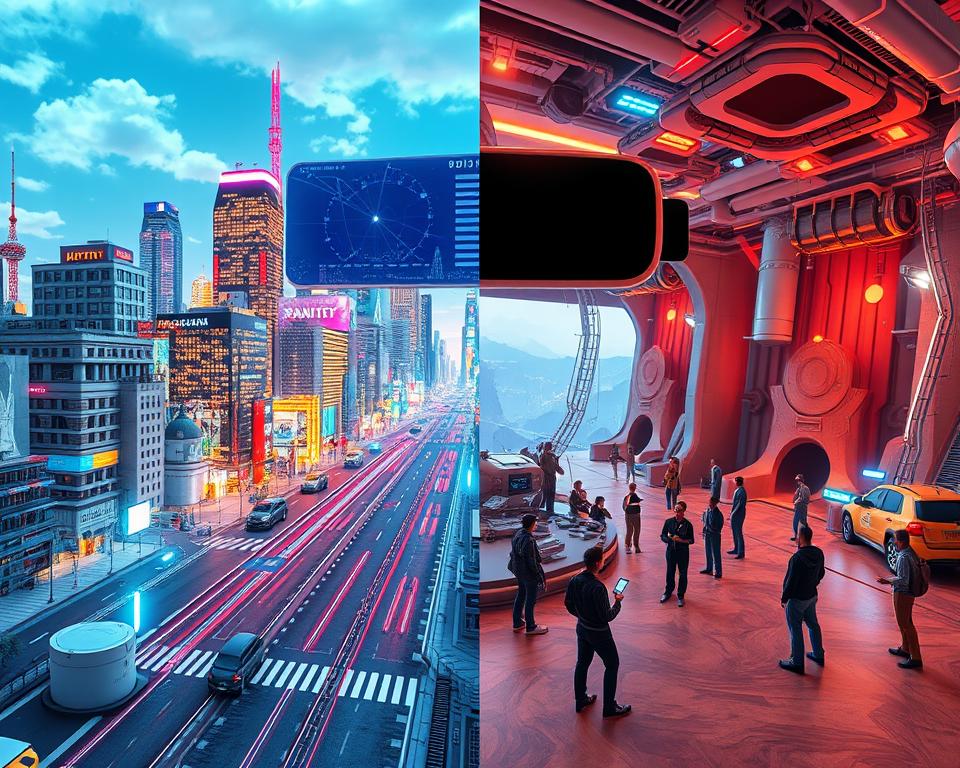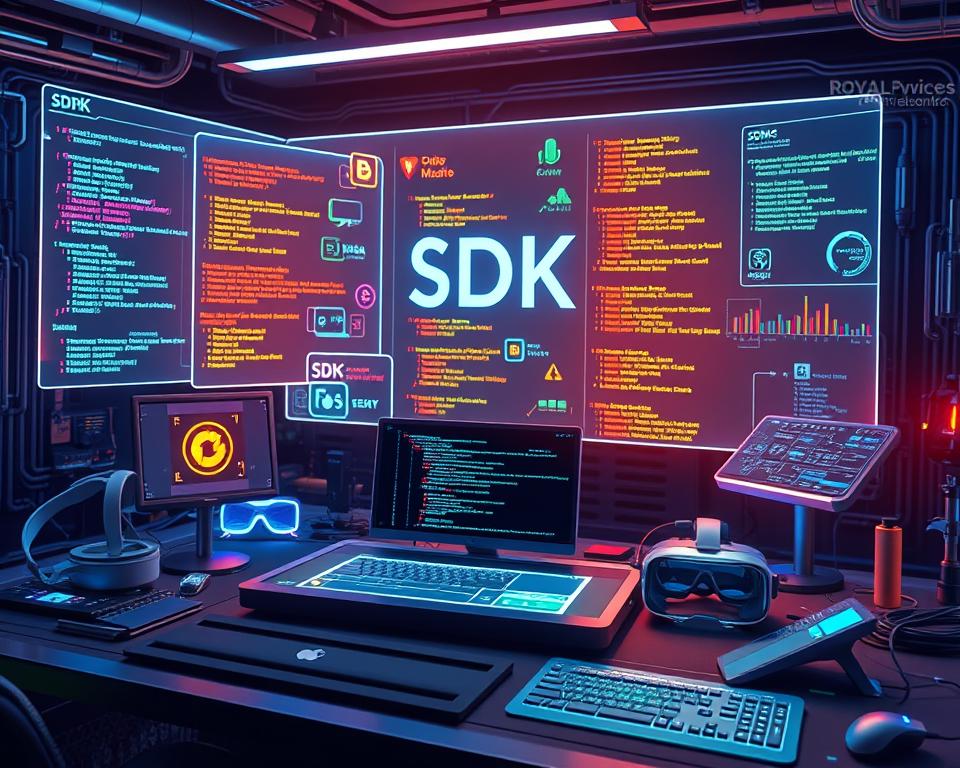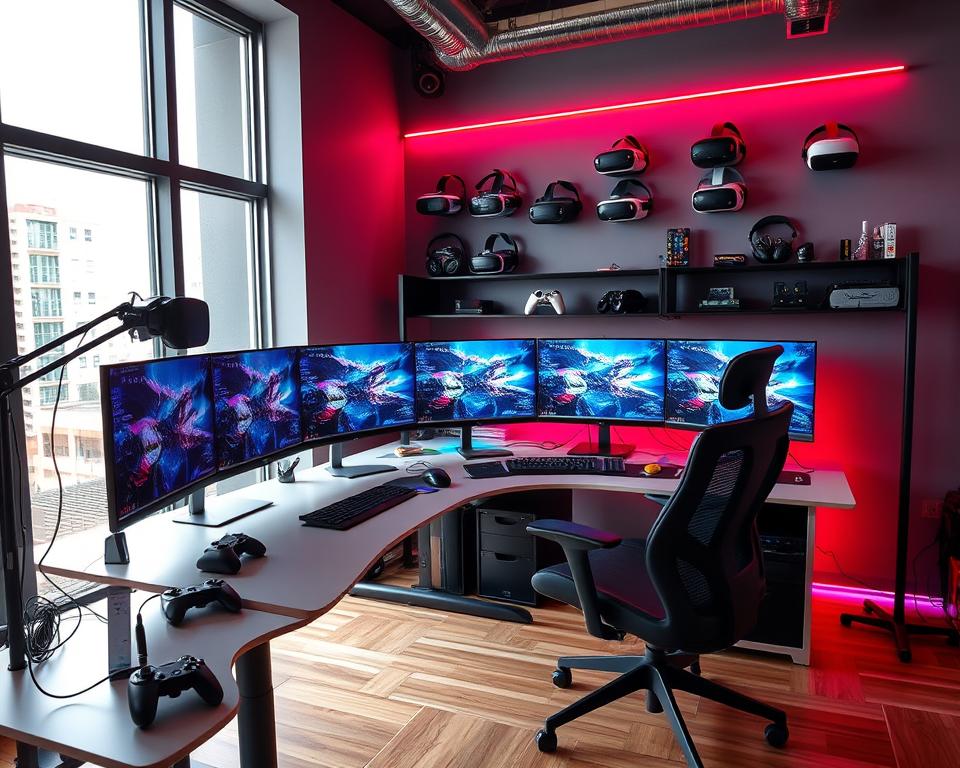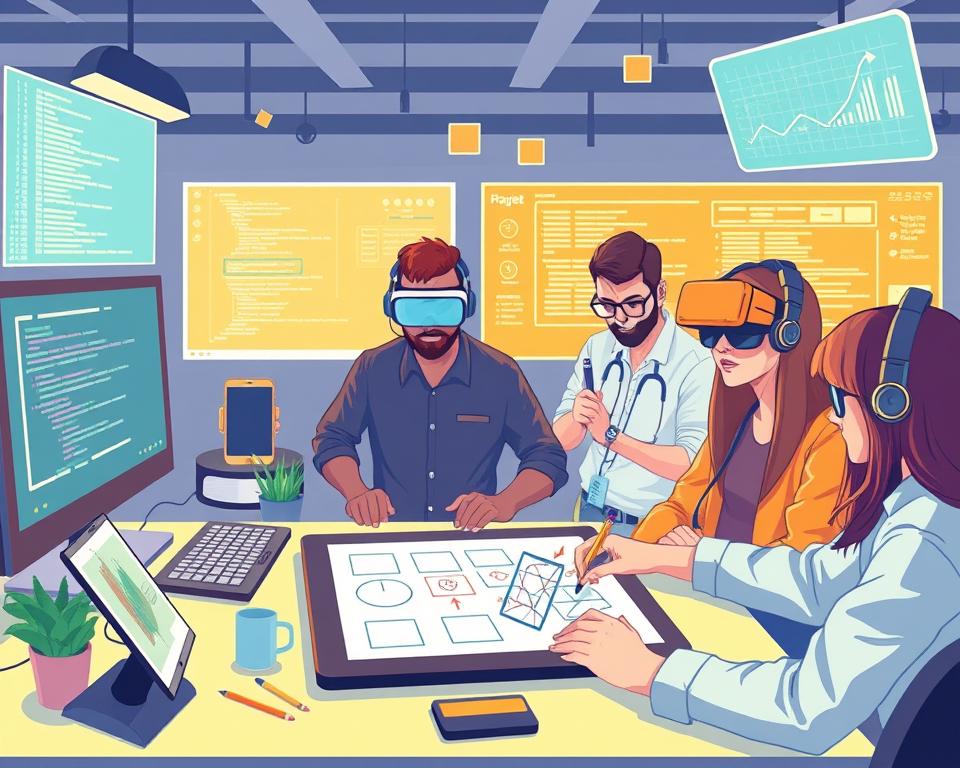Welcome to our guide on making engaging augmented reality (AR) and virtual reality (VR) mobile apps. We’ll cover the basics, the latest tools, and top tips for creating amazing mixed reality experiences for your users.
AR and VR have changed how we use digital content, mixing the real and virtual worlds. With mobile devices getting more powerful, the chance to use these technologies in app development is thrilling.
If you’re new to AR/VR or already know your way around, this guide has what you need. It will help you succeed in the world of mixed reality mobile app development.
Table of Contents
Key Takeaways
- Understand the core differences between augmented reality and virtual reality technologies
- Explore the essential hardware and software requirements for building AR/VR mobile apps
- Discover the leading development tools and SDKs available for creating immersive mobile experiences
- Learn how to set up your development environment and configure the necessary frameworks
- Gain insights into the process of developing AR/VR mobile applications, from ideation to deployment
Understanding AR/VR Technology Fundamentals
In the world of immersive tech, Augmented Reality (AR) and Virtual Reality (VR) often get mixed up. AR adds digital stuff to the real world, mixing both. VR, however, takes you into a made-up world, cutting you off from reality.
Differentiating Between AR and VR Technologies
AR uses phones or special displays to put digital stuff on top of the real world. This lets users interact with both easily. VR, though, uses headsets to block out the real world, making you feel like you’re in a different place.
Core Components of Mixed Reality Systems
At the heart of AR and VR are key parts that make them work. These include sensors to track movement, displays to show digital stuff, and computing power to make it all happen. These parts work together to create a real and engaging mixed reality experience.
Hardware and Software Requirements
To make AR/VR apps, you need the right hardware and software. You’ll need smartphones, tablets, or AR/VR headsets with strong processors and sensors. For the software, you need development platforms, game engines, and APIs to make and improve virtual worlds and connect hardware for a smooth user experience.
| AR vs VR | Key Differences |
|---|---|
| Augmented Reality (AR) | – Overlays digital content on the physical world – Allows users to interact with both real and virtual elements – Utilizes transparent displays or smartphone cameras |
| Virtual Reality (VR) | – Immerses users in a fully synthetic digital environment – Disconnects users from the real world – Requires dedicated VR headsets to completely enclose the user’s vision |
“AR and VR technologies are transforming the way we interact with digital content, blurring the lines between the physical and virtual worlds.”
Essential Development Tools and SDKs for AR/VR Apps
Creating amazing augmented reality (AR) and virtual reality (VR) apps for mobile needs special tools and SDKs. These tools help developers turn their ideas into reality. They make it easy to add cool AR/VR features to apps.
ARKit and ARCore are top choices for Apple and Android apps. They offer lots of APIs for using device sensors and advanced tech. This lets developers make amazing AR experiences.
Vuforia is great for apps on both iOS and Android. It’s known for its object and image recognition. It also has lots of help and support for developers.
OpenXR is key for VR apps. It’s a standard API that works with many devices and platforms. This means VR apps work well everywhere, giving users a smooth experience.
| AR/VR SDK | Supported Platforms | Key Features |
|---|---|---|
| ARKit | iOS | Advanced computer vision, sensor fusion, and rendering technologies for creating immersive AR experiences on Apple devices. |
| ARCore | Android | Robust AR development toolkit that leverages device sensors and Google’s AI technologies to enable rich AR applications on Android platforms. |
| Vuforia | iOS, Android | Cross-platform AR framework with powerful object and image recognition capabilities, enabling the creation of advanced AR applications. |
| OpenXR | Windows, Linux, iOS, Android | Vendor-neutral API standard that simplifies the development of VR applications, ensuring seamless compatibility across a wide range of hardware and software platforms. |
Using these top AR/VR SDKs and tools, developers can make amazing mixed reality apps. They can bring their ideas to life on mobile devices.
Setting Up Your Development Environment
To make amazing AR/VR mobile apps, you need a good development setup. This guide will help you install software and frameworks. It will also show you how to set up your tools and test environment.
Installing Required Software and Frameworks
Starting your AR/VR project means installing key software and frameworks. You’ll need to download and install tools like Unity or Unreal Engine. These tools help you create immersive experiences and handle mixed reality development.
Configuring Development Tools
After installing the software, you need to set up your tools. This includes your Integrated Development Environment (IDE) and version control systems. Making sure all tools work well together is key for a smooth workflow.
Testing Environment Setup
Testing your AR/VR apps is crucial. You’ll need to set up emulators, physical devices, and testing tools. This setup helps you find and fix problems early, making your app better for users.
By following these steps, you’ll have a great AR/VR development setup. With the right tools and a good testing environment, you can make your AR/VR ideas come to life.
How to Develop AR/VR Mobile Applications
Creating AR/VR mobile apps is both exciting and fast-paced. The AR/VR app development process covers many stages, from idea to launch. Knowing these steps helps make mobile AR/VR experiences that are fun and well-made.
The mobile AR/VR creation starts with research and idea-making. It’s important to know who your app is for and what they want. Then, you pick the right development workflow and tools to make your idea real.
A good AR/VR app development process has several main parts:
- Prototyping and wireframing: Making simple versions to check the idea and get feedback.
- Asset creation and 3D modeling: Creating 3D models, textures, and visuals.
- Integrating AR/VR frameworks: Using SDKs and platforms like ARKit, ARCore, or Vuforia for AR/VR features.
- User interface and interaction design: Making the app easy to use and fun, with gestures and voice commands.
- Performance optimization: Making sure the app runs smoothly on mobile devices.
- Testing and debugging: Checking if the app works well and is easy to use before it’s released.
By using a clear mobile AR/VR creation method and the right tools, developers can make amazing AR/VR experiences. These experiences are engaging and show what mobile computing can do.
“The future of computing is in the hands of those who can create the most compelling and immersive virtual experiences.”
Choosing the Right Platform: Unity vs. Unreal Engine
Choosing between Unity 3D and Unreal Engine is key for AR/VR mobile apps. Both are top-notch game engines with unique features. It’s crucial to know their strengths and weaknesses to pick the best for your project.
Unity Features for AR/VR Development
Unity 3D is known for its easy-to-use interface and vast plugin library. It has great tools for AR/VR, working well with many headsets. Its big community and asset library help developers work faster.
Unreal Engine Capabilities
Unreal Engine is famous for its stunning graphics and real-time rendering. It has a visual scripting system and lots of tools for complex AR/VR projects. Its support for many platforms and physics simulation make it great for immersive experiences.
Platform Comparison and Selection Criteria
- Performance: Unreal Engine has better graphics, ideal for high-end AR/VR.
- Ease of Use: Unity is easier for beginners, with a simpler interface and more resources.
- Asset Availability: Unity has more assets and plugins, while Unreal Engine is better for custom assets.
- Cross-Platform Support: Both support many platforms, but Unity might have a slight edge.
- Development Cost: Unity is free for personal use, making it great for small teams. Unreal Engine’s model is better for big projects.
When picking a platform for your AR/VR app, think about your project’s needs, your team’s skills, and the desired look and feel. By weighing Unity 3D and Unreal Engine’s strengths and weaknesses, you can choose the best fit for your goals and deliver a top-notch AR/VR experience.
Implementing 3D Graphics and Models
Creating engaging AR/VR apps needs smooth 3D graphics and models. You might make virtual worlds or add digital stuff to real life. It’s all about using 3D assets well. We’ll look at key methods and tips for 3D modeling, graphics, and making assets.
Optimizing 3D Asset Creation
For AR/VR 3D modeling, focus on making high-quality, easy-to-use assets. Use smart 3D modeling tricks like reducing polygons, optimizing textures, and managing levels of detail. This way, your models run smoothly and look great.
Integrating 3D Graphics with Development Platforms
Platforms like Unity and Unreal Engine make adding 3D graphics to apps easy. They have cool features for lighting, shading, and physics. These tools help make your 3D models real and immersive.
Optimizing 3D Graphics for Mobile Devices
AR/VR apps on mobiles face special challenges. Mobiles have less power and memory, so you need to optimize your graphics. Use tricks like compressing textures, simplifying meshes, and reducing draw calls. This ensures your app runs smoothly and looks good on many devices.
| Technique | Description | Key Benefits |
|---|---|---|
| Polygon Reduction | Reducing the number of polygons in 3D models while maintaining visual fidelity. | Improved performance, reduced memory footprint, and faster loading times. |
| Texture Optimization | Optimizing texture resolution, format, and compression to reduce file size without compromising quality. | Reduced bandwidth requirements and faster asset loading. |
| Level of Detail (LOD) | Implementing multiple versions of a 3D model with varying levels of detail, automatically switching between them based on distance and camera position. | Maintaining high-quality visuals while optimizing performance, especially in complex scenes. |
Learning how to use 3D graphics and models well lets you make amazing AR/VR apps. These apps will wow your users.
Creating Interactive User Experiences
Creating engaging AR/VR mobile apps is more than just great visuals. It’s about making experiences that feel real and interactive. This means focusing on gesture recognition, voice commands, and touch interfaces.
Gesture Recognition Implementation
AR/VR goes beyond just tapping screens. Gesture recognition lets users control virtual worlds with their hands and bodies. This makes interactions smooth and natural, improving the user’s experience.
Voice Command Integration
Voice commands are a key part of AR/VR interaction. By adding voice recognition, users can control apps with voice commands. This makes apps more accessible and user-friendly.
Touch Interface Design
Touch interfaces are still important in AR/VR apps. Designing them to work well with virtual environments is key. This ensures a seamless and enjoyable user experience.
“Crafting engaging AR/VR experiences requires a deep understanding of human-computer interaction. By mastering gesture recognition, voice commands, and touch interface design, developers can create immersive and intuitive user experiences that set their applications apart.”
Performance Optimization Techniques
Creating AR/VR mobile apps needs focus on performance to give users a smooth experience. We focus on three main areas: making graphics run smoothly, managing assets well, and using device resources wisely.
Rendering Optimization
One big challenge is making complex 3D graphics run well. Using level of detail (LOD) management, frame rate optimization, and GPU-accelerated rendering helps a lot. These methods boost the app’s mobile performance.
Asset Management
Managing assets like textures, models, and animations is key for AR/VR app optimization. Using asset bundling, texture compression, and asynchronous asset loading helps. These methods cut down memory use and make the app run better.
Efficient Device Resource Utilization
Using a device’s hardware resources well is essential for rendering optimization. Methods like multi-threading, batched draw calls, and memory management are helpful. They make the app use resources better and run smoother.
By using these techniques, developers can make AR/VR mobile apps that are smooth and fun. Even on devices with less power, users get a great experience.
“Optimizing performance is a critical aspect of developing successful AR/VR mobile applications. By leveraging the right techniques, developers can create experiences that truly captivate users and push the boundaries of what’s possible on mobile platforms.”
Integration of Sensors and Camera Systems
Creating immersive AR/VR mobile apps needs the smooth blend of sensors and cameras. These tools are key to giving users a better and more interactive experience. Let’s explore how to integrate AR/VR sensors and mobile device cameras into your app.
Accelerometer and Gyroscope Usage
The accelerometer and gyroscope sensors in phones are vital for tracking movement and orientation in AR/VR. They help detect the device’s position, tilt, and rotation. This makes interactions feel natural and intuitive. Adding these sensors to your app can greatly improve the user experience and make it more immersive.
Camera Calibration Methods
Accurate camera calibration is key for great AR/VR experiences. Calibrating the mobile device cameras ensures virtual objects are mapped correctly onto the real world. This involves setting the camera’s internal and external parameters, like focal length and position.
| Calibration Method | Advantages | Disadvantages |
|---|---|---|
| Checkerboard Calibration | Simple and widely used, provides accurate results | Requires a pre-printed checkerboard pattern |
| Marker-based Calibration | Can be done without pre-printed patterns, flexible | May be less accurate than checkerboard method |
| Self-calibration | No need for pre-printed patterns or markers | Generally less accurate than other methods |
By integrating sensors and cameras well, you can make AR/VR mobile apps that are seamless and interactive. Using accelerometers, gyroscopes, and precise camera calibration unlocks the full potential of these technologies.
Building Cross-Platform AR/VR Applications
Creating AR/VR mobile applications for many platforms is key to making immersive tech more accessible. By making platform-agnostic apps, developers can reach more people. They also ensure a smooth experience on different devices and systems.
To achieve cross-platform development, using multi-platform AR/VR frameworks and tools is essential. Tools like Unity and Unreal Engine let developers write code once. Then, they can run it on iOS, Android, and web-based virtual environments.
- Use cross-platform development frameworks like Unity and Unreal Engine to build AR/VR apps for various devices.
- Make sure your app’s interface and interactions work well on different platforms and screen sizes.
- Add features and hardware integrations, like gesture recognition or voice commands, to improve the experience on each device.
By using cross-platform development techniques, you open up many opportunities for your AR/VR mobile applications. You can reach a wide audience, offer consistent experiences, and help make this technology more widely adopted.
Testing and Debugging AR/VR Apps
AR/VR mobile apps are exciting and innovative. But, they also have their challenges. Testing and debugging are key to making these apps work smoothly. We’ll look at common issues and the best tools for testing.
Common Debug Scenarios
Debugging AR/VR apps is complex. They involve hardware, software, and user input. Here are some common problems:
- Fixing sensor issues, like bad head or hand tracking
- Improving performance, like fixing frame rate drops
- Fixing UI and interaction problems, like unresponsive gestures
- Dealing with compatibility issues on different platforms
Performance Testing Tools
To make your AR/VR app run well, you need the right tools. These tools help you check and improve your app’s performance. Here are some key areas to focus on:
- Frame Rate Analysis: Tools like Unity Profiler and Unreal Engine’s Performance Monitoring help with frame rate issues.
- Memory and CPU Optimization: Profiling tools, such as Unity Profiler and Unreal Engine’s Profiling Tools, find and fix memory and CPU problems.
- Rendering Performance: Tools like NVIDIA Nsight Graphics and AMD Radeon GPU Profiler improve your app’s rendering.
Using these tools, you can make sure your AR/VR app is smooth and fun for users.
User Interface Design for Virtual Environments
Creating user-friendly interfaces for virtual reality (VR) and augmented reality (AR) is key. Unlike 2D screens, VR UI design must be unique. It needs to understand the special needs of these virtual spaces.
Designing VR UI design and AR interface solutions is all about making experiences engaging. It’s about knowing how to make the user feel like they’re part of the virtual world. This means using gestures, voice commands, and even eye movements to interact.
Designing for Spatial Awareness
In virtual worlds, users feel like they’re really there. The UI should match this feeling. Using 3D elements, depth cues, and smart placement of UI parts can make the experience even better.
| VR UI Design Principles | AR Interface Considerations |
|---|---|
|
|
By following these guidelines, developers can make virtual spaces that grab users’ attention. They’ll offer an immersive user experience that shows off VR and AR’s full potential.
Implementing Real-Time Object Recognition
In the world of mobile apps, AR object recognition and real-time tracking are key. They make apps more fun and useful. Thanks to machine learning in AR/VR and computer vision, apps can now recognize objects in real-time. This opens up new ways for users to enjoy a more immersive experience.
Machine Learning Integration
Adding machine learning to apps is a big step for AR object recognition. These smart algorithms help apps spot and follow objects as they move. This makes the app more user-friendly and quick to respond.
Developers use pre-trained models and keep improving the algorithms. This ensures the app’s object recognition works well all the time.
Object Tracking Algorithms
Object tracking algorithms are also important for real-time tracking. They look at the camera’s pictures and update the object’s position. This keeps the app’s performance smooth and natural.
Learning about AR object recognition, real-time tracking, machine learning in AR/VR, and computer vision helps developers. They can make AR apps that are fun and full of possibilities.
Publishing Your AR/VR App
Getting your AR/VR app out there needs careful planning and following app store rules. This guide will help you through the steps to publish your mixed reality app.
Navigating App Store Submission
First, learn the app store submission rules for places like the Apple App Store and Google Play Store. These rules cover technical, content, and performance needs for app approval.
- Read and understand the platform’s specific rules and policies.
- Make sure your app meets privacy, security, and content standards.
- Get ready with a detailed app description, screenshots, and marketing materials.
- Submit your app for review and be ready to fix any issues.
Optimizing Your AR/VR App for Distribution
After approval, focus on making your app more visible and easy to find. Here are ways to boost your AR/VR app distribution:
- Use the right keywords in your app’s title, description, and metadata for better search results.
- Use app store features like featured listings and promotions to attract users.
- Keep improving your app by listening to user feedback and making updates.
By following these steps, you can make your AR/VR app more visible and popular. This opens up new chances for growth and success.
| Platform | Key Submission Guidelines | Optimization Strategies |
|---|---|---|
| Apple App Store |
|
|
| Google Play Store |
|
|
Conclusion
The world of AR/VR mobile app development is changing fast. It offers great chances for developers to explore new possibilities. This guide has given you the tools and knowledge to succeed in this field.
The future of AR/VR looks even more exciting. New technologies like photorealistic rendering and better sensors will change the game. Developers who keep up with these trends will lead the way.
AR/VR app development is both thrilling and challenging. But with the right tools and dedication, you can make amazing experiences. Whether you’re new or experienced, keep exploring and innovating in this fast-changing world.







